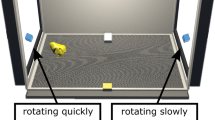Abstract
CERTAIN changes in the sensory input of an animal are immediately followed by a reaction from that animal which is the same for a variety of different changes. This orientation reaction was first described by Pavlov1, who referred to observable changes in posture such as turning the head to look or listen in a particular direction. Many other changes within the animal have been found to coincide with such movements and are therefore considered to be part of the orientation reaction2. Lynn3 has summarized the various components of the reaction which have been measured.
This is a preview of subscription content, access via your institution
Access options
Subscribe to this journal
Receive 51 print issues and online access
$199.00 per year
only $3.90 per issue
Buy this article
- Purchase on Springer Link
- Instant access to full article PDF
Prices may be subject to local taxes which are calculated during checkout
Similar content being viewed by others
References
Pavlov, I. P., Lectures on the Work of the Cerebral Hemispheres, No. 2 in Selected Works (edit. by Koshtoyants, Kh. S.), 199 (Moscow, 1924).
Sokolov, E. N., in Central Nervous System and Behaviour (edit. by Brazier, M. A.) (New York, 1960).
Lynn, R., Attention, Arousal, and the Orientation Reaction (Pergamon, 1966).
Horn, G., Nature, 215, 707 (1967).
Broom, D. M., Ph.D. thesis, Univ. Cambridge (1967).
Author information
Authors and Affiliations
Rights and permissions
About this article
Cite this article
BROOM, D. Specific Habituation by Chicks. Nature 217, 880–881 (1968). https://doi.org/10.1038/217880a0
Received:
Issue Date:
DOI: https://doi.org/10.1038/217880a0
This article is cited by
-
Why it hurts: with freedom comes the biological need for pain
Animal Cognition (2023)
-
The matter of spatial and temporal scales: a review of reindeer and caribou response to human activity
Polar Biology (2008)
Comments
By submitting a comment you agree to abide by our Terms and Community Guidelines. If you find something abusive or that does not comply with our terms or guidelines please flag it as inappropriate.



